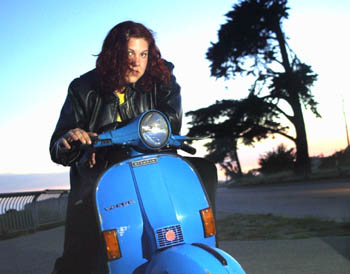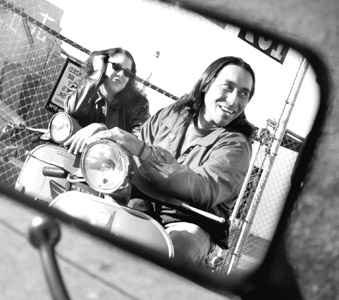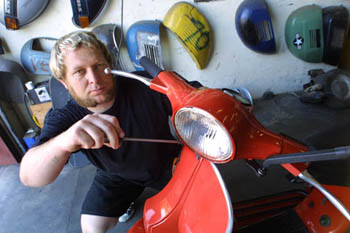![[Metroactive Features]](/features/gifs/feat468.gif)
[ Features Index | San Jose | Metroactive Central | Archives ]
 Photograph by George Sakkestad Trash Chic: Kristen Nichols rides a quarter-century-old Vespa that she maintains herself. She considers herself 'scooter trash,' in contrast to wealthy collectors who buy up restored vintage scooters and stockpile them in garages. Vespa Mania Is the Italian scooter the ultimate urban accessory or a trashy working-class ride? That depends on who you talk to--and whether you have the time to hear the true, unadulterated story of Vespa obsession. By Michael Beattie THE SCOWL on the Arizona State Trooper's face dissolved to a look of incredulity as he studied the license plate on my Vespa. "You rode all the way from New York on that?" It was August 1981 and I had only been in the United States three months, but I knew without a doubt this was not a good time to explain to the man in the hat that I had come from New York via Guadalajara, Mexico. By now I was used to whipping out the Vespa's registration and proving that this was indeed a real motorcycle, boasting a freeway-legal 15 horsepower. The trooper let me go on my way, and I resumed my interrupted journey to Lake Havasu in the torrid summer heat. One of the hardest things about making a cross-country trip on a Vespa is convincing people the trip isn't a stunt or a crazy idea. My mother, bless her expansive Italian heart, was responsible for planting the scooter bug in my soul when I was still a child. She bought me a bright orange Vespa moped when I was just 12 years old, and that was at a time when Italian law allowed 14-year-olds to ride mopeds. I immediately put my illegal Vespa to good use traveling all over the mountains around my home in Umbria, a region that in those days boasted fewer miles of paved highway than converted farmhouses owned by émigré American artists. Then I read a story about a crazed Italian who rode a Vespa from Milan to Tokyo through Iran and Afghanistan, among other places. When I met him at a motorcycle show in Milan he highly recommended the Vespa as a touring machine. So when I landed in America, I went straight to the Vespa dealer in Brooklyn and plunked down $1,500 for a brand-new P200E. I rode down to Key West, Fla., via pouring rain in the Shenandoah Valley. One time I hit a car and went flying on the Overseas Highway, my penalty for getting distracted by the tropical waters around me. The leg shield and one side of the engine cover got scraped, but everything else, including me, was fine. I slept in the streets of Guadalajara to save money and I rode to see the Pacific Ocean at Mazatlan. "Do you know Vespas are made in Italy?" I was sitting in the early morning sun in Lee Vining, admiring the view across the California desert, when a beautiful stranger with an accent approached me. Because I was from Umbria and Giovanna was from neighboring Tuscany, she agreed to load her pack on top of mine and we rode off on my uncomplaining steed. Talk about a Vespa changing one's life. First Buzz IN POST-WORLD WAR II Italy, the aeronautics company Piaggio came up with a motor scooter design that the company's president said looked like a wasp: a bulbous rear, a narrow waist and a wide front end. In Italian, vespa means wasp, a name that was reinforced by the insistent buzzing of the little lawnmower-like engine. The little motor that could was the basis on which Piaggio exploded into a multinational corporation with factories and dealerships around the world--except, of course, in the United States, where the crude two-stroke engine could no longer be tolerated in the California of the mid-1980s. Strict air quality regulations lost Piaggio its largest single U.S. market and the company pulled out of the States entirely. The funny thing was that even though Piaggio disappeared from the United States, the cult of the Vespa just grew and kept on growing in its absence. Former dealerships stayed busy importing parts and keeping the old machines running. New riders, like Kristen Nichols, were attracted to the Vespas as they passed by on the street. "I just fell in love," she says. A Vespa can easily become an obsession--especially an older one containing decades of its own history. Nichols, a member of the Santa Cruz Vampires motorcycle club, happily admits to a relationship with her Vespa that borders on the passionate. At 6 feet tall, Kristen towers over her diminutive motor scooter, a two-stroke PX125, a machine that's about as old as she is. "I don't want an automatic," the 26-year-old declares about the newer models, dismissively shaking her mane of carrot-red hair. "I want to be totally in control." And if the price she pays for that control is frequent breakdowns and the occasional seizure of the elderly two-stroke motor, so be it. The first time her Vespa seized in midstride, Kristen found herself in some serious danger. "Luckily," she says, "the truck driver behind me realized what was happening and gave me some space. The rear wheel locked and the Vespa slid sideways under me. I kind of figured I had to pull the clutch in, which got the scoot straightened out and I managed to roll to a stop." Since that encounter with piston seizure, Kristen has come to terms with breakdowns. "My Vespa never leaves me stranded," she insists, "just frustrated."
Close to the Vespa: Scooter enthusiasts Kristen Nichols and Pete Cervantes with their favorite form of transportation. Wheels of Fortune FIVE YEARS AGO, Piaggo introduced the world to its ET series, a new modular design featuring a two-stroke 50 cc engine or a four-stroke 150 cc engine. ETs are now available in the United States; still, most who own classic Vespas turn up their noses at the new Vespas. It's not just that, technologically speaking, the new scooters are different; it's also that Piaggio is marketing them to a different kind of rider--the beautiful, young, fashion-conscious urban dweller. Piaggio's first foray into the North American market pitched Vespas for their practicality, as a second car. Today the marketing is styling Vespas as the ultimate retro accessory, and riders like Kristen don't like people appropriating Vespas as fashion accessories, whether they are classic two-strokes or new four-strokes. Kristen's purist attitude is the first qualification to becoming what she calls "scooter trash." Kristen earns her living working in a welding supply store. It really bugs her that there are people who can and will buy "trophy" Vespas. To some extent the scooter trash lifestyle harkens back to the 1960s and '70s, when mods on Vespas and Lambrettas did battle, West Side Story-style, with rockers on motorcycles. And Kristen says she's often battling the stereotype propagated by the cult movie Quadrophenia. Scooter trash, it's true, do tend to like ska music, an amalgamation of soul and calypso born in the West Indies and developed in Britain. Music by the Parka Kings, Deals Gone Bad and Swingin' Utters gets rave reviews in the San Francisco-based publication Scoot Quarterly, the voice of scooter trash everywhere. Vespa rallies are also a key part of the scooterist lifestyle. Kristen recalls one rally in Arizona where everyone went on a camping trip that involved riding for hours in freezing, pouring rain. "There were potholes everywhere," she says. "We were so tired and cold when we got to the campground [that] all the girls got together and had a good cry. It was great!" The camaraderie was great even if the weather wasn't. Kristen isn't a big fan of some of the party tricks enjoyed at rallies. "Can't have a good get-together without fire," she says. "Everyone likes a campfire." But then she would never endanger her ride the way some people do: by zipping across beds of red-hot embers. It's a rare edition of Scoot Quarterly that doesn't carry some photographs of a flaming Vespa at a rally somewhere in the United States. At Café Pergolesi, other patrons greet Kristen with cries of "Scooter trash!" She bestows a radiant smile on her admirers with the aplomb of a seasoned politician, pausing to exchange a word or two with young people drinking coffee and pretending to study. The adulation from nonriders is welcome. "It's always a struggle to be a woman in a male-dominated sport. But among scooter trash there are lots more women riding and fixing their own bikes," she says. "It's no big deal if you ride a scooter. It would be harder riding a motorcycle to get acceptance." Besides, she adds, if she rode a motorcycle she'd be showing off. Vespa'd Interests I GREW UP IN ITALY, where Vespas were, and still are, just a cheap and easy way to get around. I remember one particular day, standing around in an aimless group on the sidewalk, when someone wheelied past us on his Vespa, on his way home. We all shook our heads slowly as the wasp buzzed into the distance behind a cloud of blue smoke. "Guarda questo, vuole far il fanatico in Vespa" [Look at this guy, he wants to show off on a Vespa], one teenager said sadly and we all nodded. If he wanted to impress someone, why didn't he get a proper motorcycle? Now it seems the wheel has come full circle and Vespas are all about being cool. The Vespa boutique on Franklin Street in San Francisco looks like a cool place from the outside, displaying Ferraris and Porsches and all manner of expensive cars so beloved by our dotcommer-formerly-millionaire neighbors. The industrial chic showroom also features a semicircle of ET Vespas in black and white, red and blue, turquoise and a strange shade of almost pink. The Vespa literature on display harps on about the movie Roman Holiday, in which Audrey Hepburn, playing a princess, went for an illicit Vespa ride. There's a couple on the floor, dressed in expensive, supple black leather, idly checking out the machines. They look exactly like the yuppie scum so despised by Kristen and so coveted by the new Piaggio importers. Their hair looks fashionably distressed; they view the world from behind ridiculously narrow sunglasses and totter past the scooters on absurdly thick platform sandals--just the sort of impractical footwear you can get away with even if you want to ride a Vespa. The footboards on the scooters are much more forgiving than the foot pegs on a "normal" motorcycle. I sidle past and take my first close-up look at a two-wheeler by Piaggio since I bought my own brand-new P200E in Brooklyn 20 years ago. The salesman knows less about the bikes than I do, apologizing that he is really a Rolls Royce salesman, and Irene, who deals with Vespas, isn't in. In the world of marketing, Vespa boutiques look to me to be a typically Italian business strategy, destined to snatch defeat from the jaws of victory. When I find my way to the San Francisco Scooter Center in the bowels of Hunter's Point, Barry, the owner, says quite offhand, "Want to take a ride?"--and adds casually, like a nouvelle cuisine waiter with a pepper grinder, "Want a helmet with that?" Barry tells me he once got the bike up to 75 mph, a speed the old P series scooters could only dream about. I looked like a fool, and I knew it, but I couldn't help myself. A plump middle-aged man riding the streets of San Francisco on a 150 cc scooter, in an ill-fitting helmet and wearing a Cheshire cat grin. It had been 10 years or more since my last ride on a Vespa, but even this brand new ET4, with just 70 miles on the clock, brought back the old familiar sense of fun. By the time I get back to the shop all I can think of is that, right or wrong, I want one of these machines. Kickin' It LORENZO, WHO runs the scooter section of First Kick, a San Francisco motorcycle store, is disappointed Piaggio chose not to entrust their new marketing campaign to the old scooter shops that kept the brand name alive during Vespa's 20-year hiatus from the American scene. "On the other hand," Lorenzo admits, it's up to the scooter shops to change their image a bit too. "Customers don't necessarily want to buy their $4,000 scooters in a greasy enthusiast's shop," he says with a wry grin. "They deserve swept floors, a nice display and good treatment." First Kick reminds me of a Volkswagen store, not a dealership but an enthusiasts' gathering place, as Lorenzo puts it. There are classic Vespas restored and for sale, with prices ranging from $2,600 for a 1980 PX125 to $4,200 for a red 1979 P200E with just 800 original miles on it. Scratch at Lorenzo the businessman's outer skin and underneath you'll find just another crazy scooterist. With barely any prodding, Lorenzo wheels out his own pride and joy, a 1963 Innocenti Lambretta 175, with flashing chrome and dark-blue paint. The 1960s mod restoration fits nicely with the image Lorenzo himself projects, from his short, spiky black hair through his black T-shirt and tight black jeans. "This," says Lorenzo, rocking back on his heels, admiring his thoroughbred ride, "is the ultimate urban accessory. Just like some people wear expensive watches or a nice pair of shoes to make a statement, I ride my scooter around town." That kind of accessory attitude among the new urban elite Vespa aficionados is giving Kristen, greasy Santa Cruz scooter trash, a cow. "It's a total pain in the ass," she grumbles. "Dentists and doctors are buying up all the classic scooters and putting them in their garages instead of riding them." Which, she points out, is what they were built for. Plus, all this hoarding of two-stroke Vespas is driving up the used market like crazy, putting a restored Vespa out of Kristen's financial reach. "In another life I'll have a clean, restored scooter and I'll pay those guys in San Francisco to work on it," she adds without conviction. In the meantime, Kristen keeps her PX 125 running with her own limited mechanical skills and help from her buddies. "I know the mechanical theory behind the bike, but I'm a little shy about going in myself and pulling apart, say, the gearbox. Oh, and if you are going to work on the piston, I discovered a new rule: Always start the job with a spare piston handy." According to Kristen, anyone who chooses to become scooter trash, as she styles herself, will be forced into a life of privation. "You have to be tough to ride a scooter. If you have any doubts ..." her voice trails away for a second. "Pre-Vespa, I was actually cute," she says with a faraway look in her eyes, remembering skirts and makeup and hairstyles that weren't dictated by a helmet. "I long for the days when I can wear what I want to wear."
Roman Holiday: Mike Pepper, who owns South Bay Scooter Works in Santa Clara, says working on old Vespas is both frustrating and exhiliarating. Sharp Scooter LUST FOR THE ET4 is still with me when I pull up outside the unassuming shop that is South Bay Scooter Works in Santa Clara. Owner Mike Pepper, a hairy blonde hulk with fists like turnips, is working delicately on a white Vespa frame, freshly painted but lacking any and all electrical or mechanical accessories, like lights, engines or controls. His cramped shop is lined with scooters, including a trio of Lambrettas, but mostly Vespas in various stages of assembly. Since 1994, Mike has been working on scooters, and now he's taken to buying broken scooters and scooter parts and restoring classic machines, including a 1954 Vespa (like that scooter in Roman Holiday), one of the old bikes with the headlamp on the front fender. I decide I want that, too, when it's restored. "I'm not in this business for what's new and neat," Pepper says. "I'm just another starving artist." Working on classic Vespas is "a pain in the butt," he says, but he makes the statement with a smile. Vespas are like that, it seems. Where some people get a dog to reduce their blood pressure, other people ride and fix Vespas. Mike says he, like Kristen, has come to terms with seizing two-strokes in the 10 years he's been repairing them. "It's the fuel," he notes. "Unleaded gas doesn't provide enough lubrication for the pistons, seals and bearings and things dry out. Seals break and pistons seize." The Last Ride VESPAS HAVE a way of staying with you long after they are gone. After several years, my relationship with the lovely Giovanna, who had climbed on the back so easily on the eastern side of the Sierras, ended in tears. I happily kept my Vespa for a decade, commuting with it to Cabrillo College and, later, to work. When, in a moment of madness, I decided to move to Florida, I sold the scooter to a couple of kids for $150. When they rode my machine away, there were tears in my eyes. Years have gone by, but I still wish I could buy that Vespa back. Does anybody have a white 1981 P200E with a license plate holder from King's Motorcycles, Brooklyn? I miss my long-lost traveling companion. [ San Jose | Metroactive Central | Archives ]
|
From the May 31-June 6, 2001 issue of Metro, Silicon Valley's Weekly Newspaper.
Copyright © 2001 Metro Publishing Inc. Metroactive is affiliated with the Boulevards Network.
For more information about the San Jose/Silicon Valley area, visit sanjose.com.

